
Thanks to the Wide-Beam ultrasonic transit-time measurement principle that Siemens is first to invent, and 100 Hz data update rate developed by Siemens, the SITRANS FS230 clamp-on ultrasonic gas flowmeter tolerates most wet gas conditions.
Most competing meters would be incapable of operation in such challenging environments, but the SITRANS FS230 can perform accurately even when moisture is present. Wide-Beam technology provides accuracy and reliability in numerous field installations around the world. The article also includes impact of mixtures of Hydrogen content in Natural Gas tested at DNV-GL, Netherlands on the performance of Wide-Beam sensors and FS230 flow metering system.
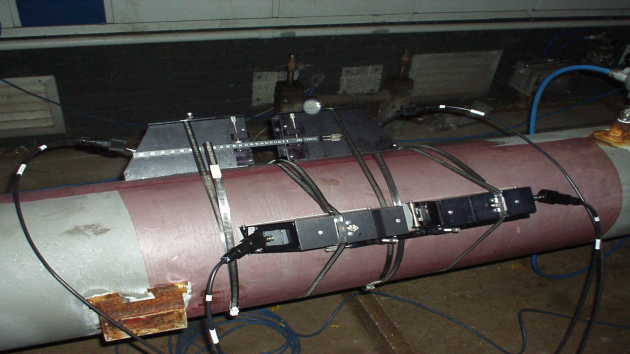
Figure 1: Siemens Wide-Beam clamp-on sensors in multi path installation measuring Natural Gas Flow.
Siemens Ultrasonic clamp-on flow meters working on “Transit Time” principle accurately measure volumetric flow of gases. It is ideal for most natural, specialty and process gas industry applications, including:
- Check metering
- Lost And Unaccounted For (LAUF) analysis
- Allocation
- Flow survey verification
- Production
- Storage
- Gas-fired power stations
Non-Intrusive & Non-Contact
As with any other flow metering device from Siemens, it is not necessary to cut the pipe or shut down operations to install the flow meter; the sensors are quickly and easily mounted on the outside of the pipe, minimizing maintenance costs and preventing deposits from forming.
- No moving parts, so it offers no obstruction or pressure drop.
- No wear and tear or fouling of wetted parts like electrodes of electro-magnetic flow meters.
- Not affected by aggressive, corrosive, or toxic liquids or gases
- No contaminants when measuring the sterile or high-purity media.
- No dependence on the pressure, temperature, and other fluid property variations.
Siemens employs Transit Time principle for its Clamp-on Ultrasonic Flow meter SITANS FS230
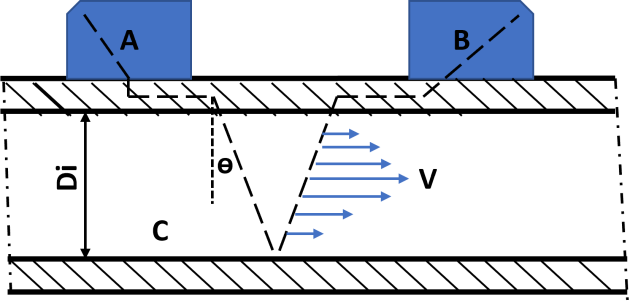
Figure 2: SITRANS FSS200 Sensors mounted in a reflect mode.
SITRANS FSS 200 clamp-on ultrasonic sensor pair A & B simultaneously transmits and receives acoustic signals directly through the pipe walls, where the refraction angle θ through the fluid is governed by Snell’s law of refraction.
Sinθ = C / Vϕ (C= speed of sound in fluid and Vϕ is phase velocity in pipe wall which is a constant).
The average transit time Tfluid of soundwaves in fluid between the sensors A and B is calculated by the advanced transmitter SITRANS FST030 by subtracting the computed fixed times within the transducers and pipe walls. The meter automatically compensates for the changes in sound velocity in fluid based on the variations in measured average transit time between sensors A and B.
The time of travel of the soundwaves from sensor A to B (TA,B) in the direction of the flow is shorter than the soundwaves that travel from sensor B to A (TB,A) against the flow. The time difference, ΔT, is used to compute the integrated velocity(V) of the fluid as shown in the equation below. Vϕ is the velocity of soundwaves that travels in the pipe wall and is constant, also known as phase velocity.
V = (Vϕ/2) x (ΔT/Tfluid)
Once the fluid velocity (V) is determined, the fluid Reynolds number is computed to apply a correction factor (KRe) for fully developed profile. This requires programing the inside pipe diameter (Di), fluid dynamic viscosity (µ) and density (ᵨ) in the transmitter SITRANS FST030. The volumetric flow rate (Q) is then calculated by the equation: Q = (KRe) x (ỻ/4) x (Di)2 x V
Wide beam or Lamb wave transit time sensors:
Siemens is a pioneer in lamb wave (Wide-Beam) sensor technology. The Wide-Beam sensors are selected based on pipe wall thickness, and they transmit a wide range of frequencies through the pipe and locates a frequency that matches close to the pipe wall. This frequency is transmitted through the fluid with the pipe acting as a wave guide. This provides a wide area of beam to optimize the signal to noise ratio and improves the measuring accuracy to +/-0.5% to +/-1% of reading. It also tolerates aeration and solid particles in the fluid much better.
Lamb wave or Wide-Beam sensors uses lower energy and are designed for steel pipes but can also be used with Aluminum and Titanium pipes. The signals are more cohesive, prominent, and precise. As a result, we can mark the arrival of the receive signal with greater accuracy. By contrast, a one size fits all approach as does our competitor, it becomes necessary to “crank-up” the transmit amplitude to blast the signal through the pipe and as a result the signal suffers by arriving less pronounced and less precise.
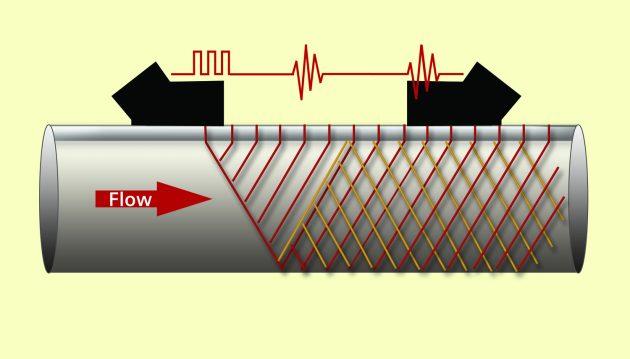
Figure 3: Lamb wave wide beam sensor where pipe is used as a wave guide.
For improved flow profile average and to get the highest accuracy, the sensors can be installed with 1, 2, 3 and 4 path on a single pipe in reflect mode or in direct mode shown below in figure 3.
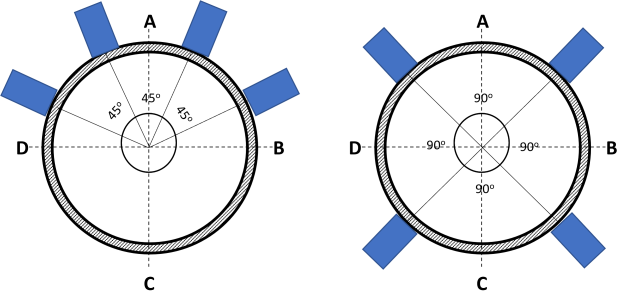
Figure 4: Four path installation in reflect mode (Left) and direct mode (right).
Higher performance with Digital SITRANS FS230
Instant digitalization of the signal, improved signal to noise ratio and reduced susceptibility to noise enhances SITRANS FS230 accuracy up to +/- 0.5% to +/-1% and repeatability of +/- 0.25% (ISO 11631) of reading. It brings the advantage of a wider turn down ratio. The fast update rate of 100 Hz from sensor interface to the transmitter and control system enables FS230 to detect and update any flow changes within 10 mS.
The DSL electronics module receives the analogue signals from the sensors which are digitized and sent to the transmitter. A SITRANS FS230 flow system comes with two options: an integrated DSL for ordinary area installations, or the external variant in an explosion-proof housing.
SITRANS FS230 with a digital platform, accurately measures volumetric flow in standard applications, but also in complex applications; it can accept pressure and temperature sensor inputs to provide accurate mass flow and volumetric flow at standard (or normal) conditions. The process values, along with extensive diagnostics parameters are available on local HMI. They are then communicated to a control system via HART or Modbus, for the operator to verify whether the flow meter is accurate and healthy.

Figure 5: The Siemens SITRANS FS230 Flowmeter System: FSS200 sensors and FST030 Transmitter.
SITRANS FS230 in gas flow measurement applications
Typical applications are the verification of the permanently installed flow meters, the measuring of high-pressure gas networks, gas power plant compressors, gas inventory balancing, gas production in chemical industry and temporary billing. The pipe sizes it can cater are DN50 to DN1500 sizes with minimum pressure of 8 bars in steel pipes and velocity of gas up to 40 meters/sec.
The SITRANS FS230 flow system for gas measurement consists of two/four pairs of SITRANS FSS200 wide beam clamp-on sensors, internal or external digital sensor link and a SITRANS FST030 transmitter as in figure 6.
Temperature changes are measure via external sensor or analogue input and pressure changes via analogue inputs to FST030 are necessary for mass flow and standard volume flow corrections.
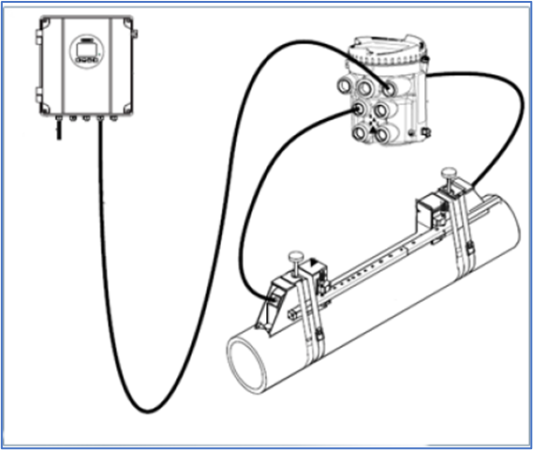
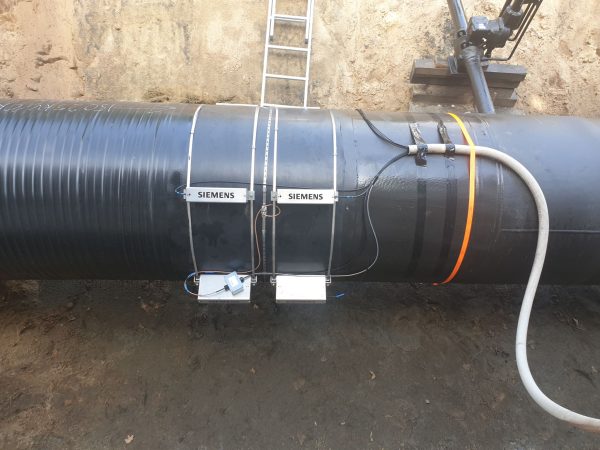
Figure 6: Clamp-on flow meter SITRANS FS230 system components and natural gas flow measurement application with “Soundcoat” to enable operations at low amplitude signals found in gas measurement
Sending ultrasonic signals through a gas is a challenge. At low pressure conditions, the signals are being scattered a lot more, causing a lower signal-to-noise ratio. Using Lamb wave Sensors with Wide Beam Technology can remedy this. Flow speeds of up to 40 m/s and more can cause beam blowing but the angle of incidence is much smaller than in liquid applications and thus the sensor distance is also smaller which mitigates the effect of high flow speeds on the sonic signals.
SITRANS FST030 transmitter has an internal AGA 8 gas table, which was created with the current gas chemical composition, taking pressure and temperature into account. Based on the actual measured values of the current flow rate, the FS230 accesses the AGA 8 gas table and determines the current viscosity, calculates the Reynolds number, and corrects the volume flow accordingly and able to output the current volume or to carry out the mass or a standard volume calculation.
Test of impact of Hydrogen Content up to 30% in Natural Gas on SITRANS FS230 Clamp-on Flowmeter
DNV-GL in Groningen, Netherlands have performed the test on their multi-phase loop test bench using 5 different gas mixtures (Pure Nitrogen, Natural Gas or G gas, Ggas+10% Hydrogen, Ggas+20% Hydrogen, Ggas+30% Hydrogen) at two different pressure conditions 16bar and 32 bar.
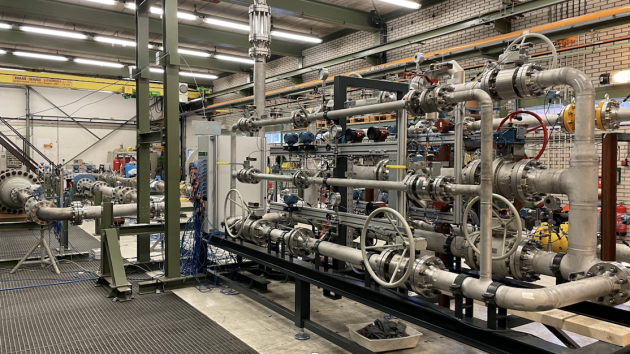
Figure 7: DNV multi-phase loop test bench
Test
- Flow rate: Qmin: 16 m³/h, Qmax 900m³h (flow velocity: 0.2 m/s – 15 m/s)
- 20 test runs of three repetitions at the test points for 100 seconds each
- Sensors were mounted on DNV’s own pipeline without any calibration before the test!!
- The test measurements for natural gas showed a typical measurement error of ~1.3% which is taken as a reference value for subsequent measurements
Test System: SITRANS FS230 (GAS) on a DN150 on a 6” SCH40 Steel Pipe

Figure 8: Wide-Beam Sensors FSS200 in 2-path reflect mount, FS230 transmitter and External DSL
Results: SITRANS FS230 Repeatability and average meter errors and its drift behavior

Figure 9: Summarized Calibration Results for Test on SITRANS FS230 Gas Flow Measurement system
Local manufacturing and Digitalization
Siemens in Peterborough is a local Canadian manufacturing hub of Siemens process instruments including Clamp-on flow meters and delivers quality instruments with the shortest lead time possible.
The clamp-on flow meter SITRANS FS230 are easily integrated into the cloud-based Siemens Mindsphere Platform for leak detection and similar remote applications using Siemens Apps.
Siemens Process Instrumentation products are distributed in Quebec and Ontario exclusively by Franklin Empire.
Links for more information:
1) www.siemens.com/fs230 for technical information case studies and PIA life cycle portal
2) https://franklinempire.com/en/flow-measurement to book a meeting with a Franklin Empire Process Instrumentation Specialist
Print this page